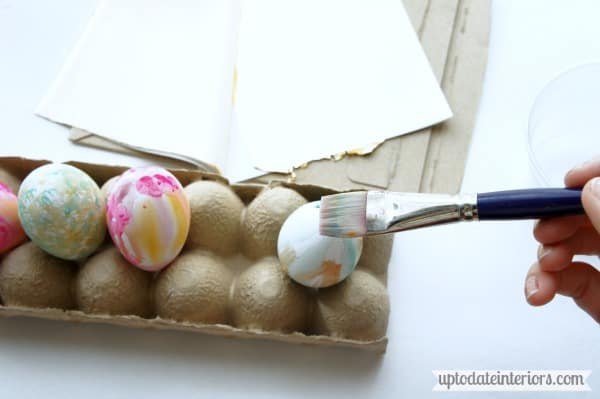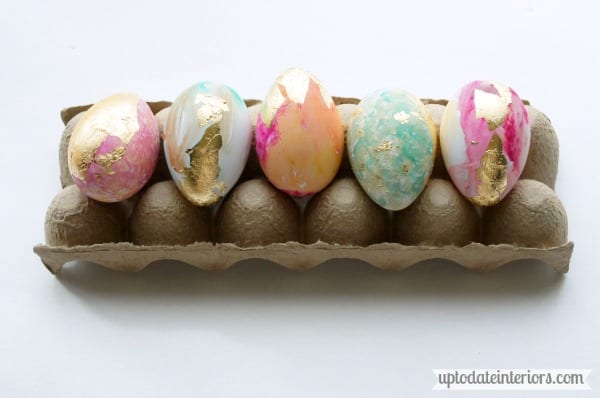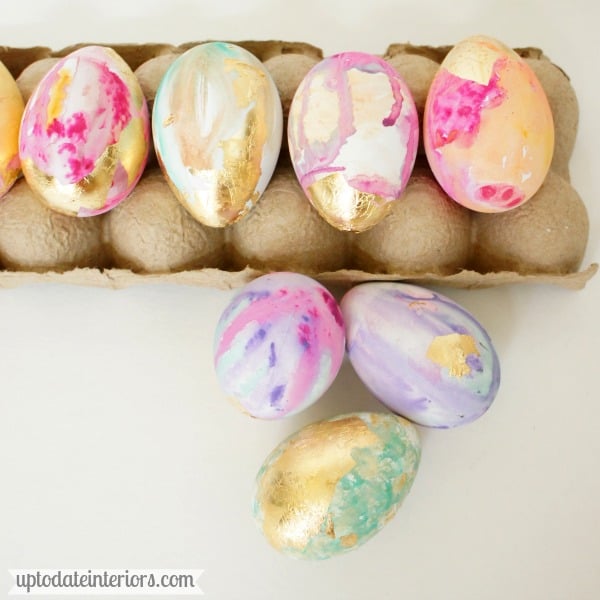Here’s How to Make Gold-leaf Watercolor Easter Eggs Easily
Create beautiful seasonal decor with gold-leaf watercolor Easter eggs. Follow easy step-by-step instructions for different techniques.
I love creating unique seasonal decor and gold-leaf and watercolor eggs were on the top of my list this year. When I’m looking for fresh ideas I take inventory of the crafting supplies I already have or even household/kitchen supplies that can be used.
I’ve had a pack of metallic sheets for gilding projects that has lasted me years and I usually have many types of paint on hand. So I decided to blend the two!
Check out how easy it is to create these beauties.
Watercolor Easter Eggs with Gold Leaf
What you need for gold-leaf watercolor eggs
Before starting this fun project, gather essential materials such as eggs, watercolor paints and supplies, water, and gold leaf and supplies. Prepare a surface that can be easily wiped clean like a kitchen counter.
Check the list below for the detailed supply list.
Eggs
- Opt for blown-out or fake eggs to ensure longevity and safety. Plastic decorating eggs, readily available at stores like Wal-Mart, are an excellent choice and are inexpensive. They look and feel like real eggs while providing a sturdy canvas for your artistic endeavors.
- You’ll also need something to place the eggs on to hold them upright while you paint. An upside-down egg carton, small dishes, or egg cups are good options.

How to Blow Out Eggs for Crafting
Blowing out eggs is a simple process that involves removing the egg's contents through a small hole, leaving an empty shell for crafting. Here's a step-by-step guide:
Materials
- Eggs
- Needle or pin
- Bowl
- Towel or paper towel
Instructions
1. Select Eggs: Choose the eggs you want to blow out. Make sure they are clean and free from cracks.
2. Poke Holes:
- At one end of the egg, use a pin or needle to gently poke a small hole. This will be the top hole.
- Flip the egg and repeat the process on the other end, creating a slightly larger hole. This will be the bottom hole.
3. Enlarge Bottom Hole:
- Carefully wiggle the pin or needle in the bottom hole to enlarge it slightly. This helps in easier blowing.
4. Position Over Bowl:
- Hold the egg over a bowl with the larger hole facing down.
5. Blow Through the Top Hole:
- Place your lips over the top hole and blow gently. The egg's contents will start coming out through the bottom hole and into the bowl.
6. Alternate Blowing and Draining:
- Periodically pause blowing and allow the egg's contents to drain fully into the bowl.
7. Rinse and Dry:
- Rinse the empty eggshell with water to remove any remaining egg residue.
- Turn the egg upside down on a towel or paper towel to dry.
Notes
Now, you have a hollow eggshell ready for crafting! Keep in mind that this process requires a gentle touch to avoid cracking the eggshell.
Watercolor Paints and Brushes
- Purchasing a starter set of watercolor paints, brushes, and a palette is usually the least expensive way to get all of the supplies and are readily available at craft stores and general merchandise retailers.
- Make sure to have a cup of water and paper towels on hand for easy rinsing and cleanup.
Gold Leaf Sheets and Adhesive
- Gold leaf can be purchased online or at your local craft store. You’ll need decoupage glue or a mixture of 50% craft glue 50% water and a clean brush for application. This combination will serve as the adhesive for applying the delicate gold leaf to your watercolor eggs.
Protective Gear
- Consider using protective gear such as disposable gloves to prevent the transfer of oils from your hands onto the eggs or fingerprints on the gold leaf. This ensures the longevity of your artwork and keeps the gold leaf securely in place. Also, don’t fret if you do not have disposable gloves on hand. The eggs will still look beautiful.
Alright, let’s get started. If you are comfortable with watercolors, then have fun! Otherwise, you can follow my steps. I already have my colors ready at this point. (You can use a plastic plate or wax paper to put your paints on.)
How to create gold-leaf watercolor eggs
Wet watercolor paint technique
Use watercolor in the traditional method with water and hues to create watercolor patterns! If you are unsure of how to use watercolors, try the steps below.
- Submerge your egg into the cup of water and place it on an egg stand. (An upside-down egg carton works nicely too!)
- Dip your paintbrush into the paint and start at the top of the egg with a small glob of color.
- Keep dipping your brush into the water and then on the paint glob with a little pressure to encourage the paint to run down the sides.
- Once you are happy with that color, add as many more as you would like but be careful not to muddle all of the colors together. I added a little color on top of the purple but pressed my brush on the exposed white parts of the egg too.
Dry dabbing technique
Looking to add a unique twist to your watercolor eggs? Experiment with the playful dabbing technique, reminiscent of sponge painting walls. This creative approach introduces different textures, making your Easter eggs truly stand out.
- Dry your brush (dab on a paper towel a couple of times), dip into paint, and dab all over the egg.
- Then use a second color and dab on the egg blending a little with the first color.
Drying Process:
After you have finished with the watercolor painting, allow the eggs to dry properly for about an hour to ensure the next step of applying gold leaf will be smooth and successful.
Applying Gold Leaf:
To apply gold leaf, dip your brush into the glue/water mixture and start with a small amount on your egg (be careful, the glue will run) and then place a small bit of gold leaf on top.
Try not to handle the gold leaf too much otherwise, your fingers will get all sticky and the gold leaf will come off. Once you are done with the gold leaf, very gently press your paintbrush on top to smooth down the pieces.
There’s no right or wrong way for how much gold leaf you apply, allowing you the freedom to create bold statements with larger pieces or add a sprinkling of gold for a more subtle effect.
Commonly Asked Questions about Handmade Watercolor Eggs
Can I use real eggs for this project?
You can blow out the yoke and whites from eggs to use for this project or buy craft eggs. This ensures the longevity of your crafted Easter eggs.
Do I need special watercolor paints for this project?
Use vibrant colors and good-quality watercolors to achieve the desired effect on your eggs. Experiment with different color combinations.
How do I apply gold leaf to the eggs?
Applying gold leaf requires delicacy. First, dip your brush into a mixture of 1/2 glue and 1/2 water. Apply a small amount of this mixture to your egg, as the glue may run. Then, gently place bits of gold leaf on top. Avoid excessive handling of the gold leaf to prevent it from coming off. After applying, press your paintbrush gently on top to smooth down the pieces.
Can I use different techniques for watercoloring?
Absolutely! Besides the traditional watercoloring method, you can experiment with the dabbing technique. Dry your brush, dip it into the paint, and dab it all over the egg. Then, use a second color, dabbing it on the egg and blending it slightly with the first color. This technique adds a playful and textured element to your Easter eggs.
How should I let the eggs dry after watercoloring?
Allow the eggs to air dry for about an hour before moving on to the gold leaf application.
I am beyond excited about how these turned out. Let me know what you do with your Easter eggs this year. Do you think you might try watercolor or gold leaf?
You can find all the best decorating ideas and DIYs for Spring and Easter on this page! It also includes seasonal printables, checklists, and worksheets for Spring decluttering and organizing.

- Here’s How to Make Gold-leaf Watercolor Easter Eggs Easily
 Create beautiful seasonal decor with gold-leaf watercolor Easter eggs. Follow easy step-by-step instructions for different techniques. I love creating unique seasonal decor and gold-leaf and watercolor eggs were on the…
Create beautiful seasonal decor with gold-leaf watercolor Easter eggs. Follow easy step-by-step instructions for different techniques. I love creating unique seasonal decor and gold-leaf and watercolor eggs were on the… - Cheerful Blooms: A Colorful Floral Spring Home Tour with Free Printable
 Join our colorful floral Spring home tour. Find creative decor ideas that bring cheerful floral accents and vibrant colors to every room. Warm greetings, dear friend and fellow decor enthusiast….
Join our colorful floral Spring home tour. Find creative decor ideas that bring cheerful floral accents and vibrant colors to every room. Warm greetings, dear friend and fellow decor enthusiast…. - Crafting Feathered Friends: A Step-by-Step Guide to DIY Paper Mache Birds
 Learn how to make paper mache birds with supplies you already have using this easy DIY and step by step instructions for handmade modern decor.“ Birds of a feather stick…
Learn how to make paper mache birds with supplies you already have using this easy DIY and step by step instructions for handmade modern decor.“ Birds of a feather stick… - Simple Remote Control Storage Ideas that are Actually Beautiful
 Chic and practical solutions for hiding remote controls on your coffee table and where to find them. Plus hand-picked store options. Hey there fellow decorator! If you are anything like…
Chic and practical solutions for hiding remote controls on your coffee table and where to find them. Plus hand-picked store options. Hey there fellow decorator! If you are anything like… - Learn How to Make Beautiful Washi Paper Eggs with Decoupage
 Make these gorgeous DIY decoupage easter eggs with plastic eggs from the dollar store and washi or origami paper in a few simple steps. Spring is in the air and…
Make these gorgeous DIY decoupage easter eggs with plastic eggs from the dollar store and washi or origami paper in a few simple steps. Spring is in the air and…




















Love these! pinning right now
Thank you! So glad you like them!!
I just adore this idea!! You are giving more DIY project ideas than I have time to actually create. Keep ’em coming though!
Okey dokey Stephanie! So glad you are enjoying the Spring Crafts. 🙂
How cool is this!!! Thank you for sharing Kathy!! 🙂 I wish I had little ones to decorate eggs with! 🙂
LOL, I saved some eggs for the kids to dye but I actually do my crafts while they are at school. 🙂
These are so pretty! I love this!!!
These eggs are really pretty and would me great to sit out in a basket at the front door! My boys could definitely pull this off. love it!
That’s a great idea! Thanks for stopping by. 🙂
Gorgeous gorgeous gorgeous! I must try! Thank you for sharing these beauties with us 😀 Its great to see so many 🙂 smiles throughout a post too. I do it all the time! Thanks.
LOL Thanks! I think I grin from ear to ear to when I am writing about crafts and decor. So glad you stopped by! 😉
Make sure you have a disclaimer that you cannot do this with eggs to be eaten. Some watercolors are harmful. I know you wrote to use blown out eggs or fake, but just be clear.
Good point! That is why I said to use the faux or blown-out eggs but you are right about the disclaimer. There can be lead in the water colors (or other paints) I will add that in!